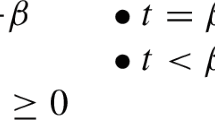Abstract
Many computational problems linked to uncertainty and preference management can be expressed in terms of computing the marginal(s) of a combination of a collection of valuation functions. Shenoy and Shafer showed how such a computation can be performed using a local computation scheme. A major strength of this work is that it is based on an algebraic description: what is proved is the correctness of the local computation algorithm under a few axioms on the algebraic structure. The instantiations of the framework in practice make use of totally ordered scales. The present paper focuses on the use of partially ordered scales and examines how such scales can be cast in the Shafer–Shenoy framework and thus benefit from local computation algorithms. It also provides several examples of such scales, thus showing that each of the algebraic structures explored here is of interest.
Similar content being viewed by others
References
Benferhat, S., Lagrue, S., & Papini, O. (2005). Revision of partially ordered information: Axiomatization, semantics and iteration. In IJCAI’05, proceedings of the nineteenth international joint conference on artificial intelligence (pp. 376–381).
Bistarelli, S., Montanari, U., & Rossi, F. (1995). Constraint solving over semirings. In IJCAI’95 (pp. 624–630).
Bistarelli, S., Montanari, U., & Rossi, F. (1997). Semiring-based constraint satisfaction and optimization. Journal of the ACM, 44(2), 201–236.
Boutilier, C., Brafman, R., Domshlak, C., Hoos, H., & Poole, D. (2004). CP-nets: A tool for representing and reasoning with conditional ceteris paribus statements. Journal of Artificial Intelligence Research, 21, 135–191.
Brewka, G. (1989). Preferred subtheories: An extended logical framework for default reasoning. In IJCAI’89 (pp. 1043–1048).
Dubois, D., & Fargier, H. (2006). Qualitative decision making with bipolar information. In KR’06 (pp. 175–186).
Dubois, D., Lang, J., & Prade, H. (1991). Timed possibilistic logic. Fundamenta Informaticae, 15(3–4), 211–234.
Dubus, J.-P., Gonzales, C., & Perny, P. (2009). Multiobjective optimization using GAI models. In IJCAI’09 (pp. 1902–1907).
Fargier, H., & Wilson, N. (2009). Local computation schemes with partially ordered preferences. In ECSQARU’09 (pp. 34–45).
Freuder, E., & Wallace, R. (1992). Partial constraint satisfaction. Artificial Intelligence, 58(1–3), 21–70.
Friedman, N., & Halpern, J. (1996). Plausibility measures and default reasoning. In AAAI’96 (pp. 1297–1304).
Giunchiglia, E., & Maratea, M. (2007). Planning as satisfiability with preferences. In AAAI’07 (pp. 987–992).
Henig, M. I. (1985). The shortest path problem with two objective functions. European Journal of Operational Research, 25, 281–291.
Kohlas, J. (2003). Information algebras: Generic structures for inference. New York: Springer (2003).
Kohlas, J., & Wilson, N. (2008). Semiring induced valuation algebras: Exact and approximate local computation algorithms. Artificial Intelligence, 172, 1360–1399.
Lindström, S., & Rabinowicz, W. (1989). Epistemic entrenchment with incomparabilities and relational belief revision. In The logic of theory change, workshop, Konstanz, FRG, 13–15 October 1989. Proceedings (pp. 93–126).
Papadimitriou, C. H., & Yannakakis, M. (2000). On the approximability of trade-offs and optimal access of web sources (extended abstract). In FOCS’00 (pp. 86–92).
Rollon, E. (2008). Multi-objective optimization for graphical models. Ph.D. thesis, Universitat Politècnica de Catalunya, Barcelona, Spain.
Rollon, E., & Larrosa, J. (2006). Bucket elimination for multiobjective optimization problems. Journal of Heuristics, 12(4–5), 307–328.
Roy, B. (1991). The outranking approach and the foundations of ELECTRE methods. Theory and Decision, 31(1), 49–73.
Schiex, T., Fargier, H., & Verfaillie, G. (1995). Valued constraint satisfaction problems: Hard and easy problems. In IJCAI’95 (pp. 631–637). Montreal.
Shenoy, P. P. (1990). Valuation-based systems for discrete optimisation. In UAI’90 (pp. 385–400).
Shenoy, P. P., & Shafer, G. (1988). Axioms for probability and belief-function propagation. In UAI’88 (pp. 169–198).
Wilson, N. (1995). An order of magnitude calculus. In UAI’95 (pp. 548–555).
Wilson, N. (2006). A logic of soft constraints based on partially ordered preferences. Journal of Heuristics, 12(4–5), 241–262.
Author information
Authors and Affiliations
Corresponding author
Rights and permissions
About this article
Cite this article
Fargier, H., Rollon, E. & Wilson, N. Enabling local computation for partially ordered preferences. Constraints 15, 516–539 (2010). https://doi.org/10.1007/s10601-010-9094-z
Published:
Issue Date:
DOI: https://doi.org/10.1007/s10601-010-9094-z




